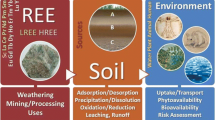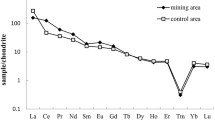Abstract
The rare-earth element (REE) contents of water and vegetables from two typical REE-high background regions and a normal region in Gannan, Jiangxi Province, indicated that the REE contents were significantly different from those of water and vegetables, respectively. The average values are 0.03 mg/L and 0.11 mg/L REE for water from regions A and B. As the REE contents of vegetables from region A are different from region B, it is suggested that there are a number of factors controlling the REE distribution from those among plants. By comparing with the normal region, the soluble REE contents of water from the REE-high background regions are higher than those of the normal region by factors of 18 and 68, respectively. The REE contents of most plants and crops from regions A and B are higher than those of the normal region. It is clear that the REEs are the indispensable elements of plants during their growing period. Why are the REE contents of some plants from regions A and B usually higher than those from the normal region? The answer is that the plants and crops have passively absorbed REE during their growth.
Similar content being viewed by others
References
X. Y. Dong, S. F. Zhu, X. Q. Yan, Z. X. Wang, and Y. B. Wang, Subchronic toxicity experiment of rare earth nitrate on rats (in Chinese), J. Chin. Rare Earth Soc. Special Issue 71–74 (1985).
K. L. Zhang, C. H., Tan, and Z. M. Tian, Experimental study on subchronic toxicity of rare earth nitrate in rabbit (in Chinese), J. Chin. Rare Earth Soc. Special Issue 91–94 (1985).
C. H. Evans, Biochemistry of the Lanthanides, Plenum, New York, pp. 353–359 (1990).
Y. J. Ji, M. Z. Cui, S. Q., Gao, S. H. Wang, J. Yu, and L. Cai, The experimental study on the subchronic toxicity of rare earth nitrate in rats (in Chinese), J. Chin. Rare Earth Soc. Special Issue 65–70 (1985).
Y. J. Ji, Toxicological study on safety evaluation of rare earths used in agriculture (in Chinese), J. Chin. Rare Earth Soc. Special Issue 1–4 (1985).
6.W. F. Zhu, S. Q. Xu, H. Zhang, P. P. Shao, D. S. Wu, W. J. Yang, et al., Investigation of children intelligence quotient in REE mining area—I. Bio-effect study of REE mining area in South Jiangxi (in Chinese), Chin. Sci. Bull. 41(10), 914–916 (1996).
W. F. Zhu, S. Q. Xu, P. P. Shao, H. Zhang, D. S. Wu, W. J. Yang, et al., Bioelectrical activity of the central nervous system among populations in a rare earth element area, Biol. Trace Element Res. 57, 71–77 (1997).
H. Zhang, J. Feng, W. F. Zhu, S. Q. Xu, P. P. Shao, D. S. Wu, et al., Chronic toxicity of rare-earth elements on human beings: implications of blood biochemical indices in REE-high regions, South Jiangxi, Biol. Trace Element Res. 73, 1–17 (2000).
W. F. Zhu, S. Q. Xu, D. S. Wu, P. P. Shao, W. J. Yang, H. Zhang, et al., Investigation on arteriosclerosis among population in a rare earth area in South China, Biol. Trace Element Res. 59, 93–98 (1997).
W. F. Zhu, S. Q. Xu, P. P. Shao, H. Zhang, D. S. Wu, W. J. Yang, et al., Investigation on intake allowance of rare earth—a study on bio-effect of rare earth in South Jiangxi (in Chinese), China Environ. Sci. 17(1), 63–66 (1997).
Y. J. Ji, M. C. Cui, S. H. Wang, J. L. Li, and J. Q. Zhang, The investigation for productive environment of rare earth nitrate (in Chinese), J. Chin. Rare Earth Soc. Special Issue 103–106 (1985).
Z. C. Chen, J. Wu, W. M. Zhuang, S. Y. Zhao, Z. M. Wang, and H. J. Ye, REE content investigation of organisms affected by drenching water from waste residue of REE mine (in Chinese), Rare Earth 14(1), 43–46 (1993).
S. C. Hu, Study on the toxicity of rare earth nitrate in hydrobionts (in Chinese), J. Chin. Rare Earth Soc. Special Issue 16–21 (1985).
J. C. Laul and W. C. Weimer, Behavior of REE in geological and biological systems, Rare Earths Mod. Sci. Technol. 15(2), 531 (1982).
Z. R. Wang, H. C. Zhang, and X. C. Zhi, Characteristics of rare earth geochemistry in plant (in Chinese), Rare Earth 17(5), 66–68 (1996).
Author information
Authors and Affiliations
Rights and permissions
About this article
Cite this article
Zhang, H., Feng, J., Zhu, W. et al. Rare-earth element distribution characteristics of biological chains in rare-earth element-high background regions and their implications. Biol Trace Elem Res 73, 19–27 (2000). https://doi.org/10.1385/BTER:73:1:19
Received:
Accepted:
Issue Date:
DOI: https://doi.org/10.1385/BTER:73:1:19




